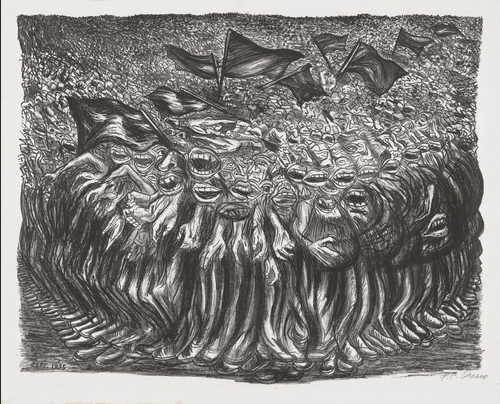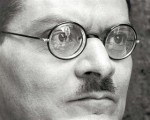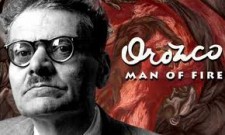
José Clemente Orozco
Mexican, 1883-1949
Las masas, (The Masses, Demonstration Note I), 1935
lithograph, 21/120
13 1/4 x 16 1/2 in.
SBMA, Gift of Mr. Robert M. Light
1994.15.1

Undated photo of Orozco
"Painting assails the mind. It persuades the heart." - José Clemente Orozco

OROZCO: Man of Fire, narrated by Anjelica Huston, broadcast on PBS American Masters. In OROZCO: Man of Fire, Directors Laurie Coyle and Rick Tejada-Flores create a visually arresting and whimsical documentary portrait of Mexican muralist José Clemente Orozco (1883-1949), whose dramatic life, iconoclastic personality and dynamic painting changed the way we see art and politics. The artist’s story is played out against the backdrop of the Mexican Revolution, the Great Depression and both World Wars. Orozco survived the loss of his left hand and the destruction of two thirds of his early work by U.S. border agents. He and his colleagues Diego Rivera and David Alfaro Siqueiros launched the Mexican mural movement that captured the imagination of Depression era America. When Franklin Delano Roosevelt put American artists to work on public walls during the 1930s, he looked to the Mexican mural renaissance as a model. Orozco had a far-reaching influence on subsequent generations of American artists, including such important figures as Thomas Hart Benton, Jackson Pollock, Jacob Lawrence and the Chicano mural movement. Although Orozco was an exceptional figure, his travels back and forth across the U.S.-Mexico border are emblematic of the experiences of millions of Mexican migrants and immigrants who come seeking a better life in the United States. His personal convictions and tenacity in the face of daunting obstacles make him a compelling figure with universal appeal. The documentary weaves a rich tapestry of images and sound, evoking Orozco’s artistic style, while opening a window onto the artist’s inner life, passions and convictions.
COMMENTS
Orozco left to the history of art not only a series of portentous and violent murals, which he painted in Mexico and the United States; in his engravings he left a legacy of his plastic ideas, and his very personal expression. It is for this reason that Orozco has become, among the great Mexican muralists, the one who can best be studied by means of his graphic works, which contain the same sense of grandeur as his frescos [sic].
Also, this evaluation is possible because Orozco’s vision as a painter was monochromatic, like certain Italian artists of the Renaissance. Even when some of his murals are resplendent with color, the pigments never serve to construct the form but only to illuminate it; to accentuate rather than produce it. Orozco, therefore, is chiefly a draftsman, who creative vision can be considered “black and white.”
In his graphic works, especially in his lithographs, there appear themes treated with slight variations, which the artist used later in his murals. In other cases, he reproduced in his prints fragments of his murals. In his lithographs we always find a perfectly controlled and fluid line, which he uses with the vehemence of a whip. Therefore, his lithography is, more than any other medium, the one most closely related to his murals, or the one that reflects best his ideas as a muralist. His engravings, on the other hand, are more like this easel paintings; we find the message more hidden, and the expression more formalistic.
- The Graphic Works of Orozco, Pan American Union, Washington D.C., 1952
SBMA CURATORIAL LABELS
Distinguished as one of Los Tres Grandes, or The Big Three of Mexican muralism, José Clemente Orozco dedicated his career to public art forms that portrayed the collective social and political power of the working class. The theme of “the masses” first appeared in Orozco’s oeuvre when he produced satirical comics on the subject for Dr. Atl’s political magazine La Vangardia in 1915. It wasn’t until 1940 that these faceless assemblies became a presence in Orozco’s murals, specifically in his program for the Gabino Ortiz Public Library in Jiquilpan, Jalisco. During the twenty-five year interim period, Orozco produced many variations on this theme.
In this graphic versions, individuals surrender their unique identities to the aggregate body of the crowd which takes on a life of its own, animated by a seemingly infinite number of watchful eyes, restless legs, and clamorous mouths. The dense compositions and agitated lines convey the intensity and energy of the masses and characterize the visual potency of Orozco’s influential style.
- SBMA Wall Text, 2000
